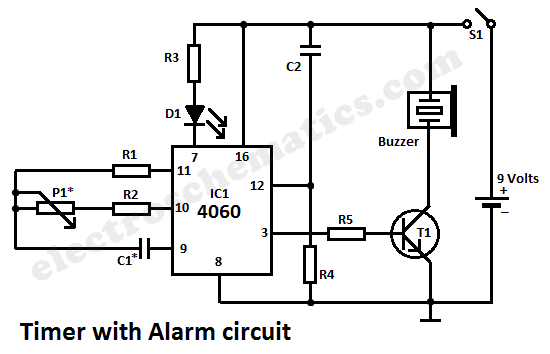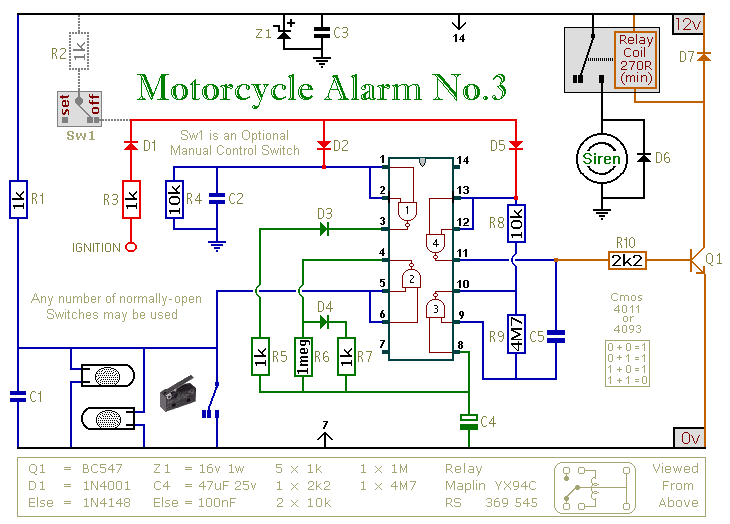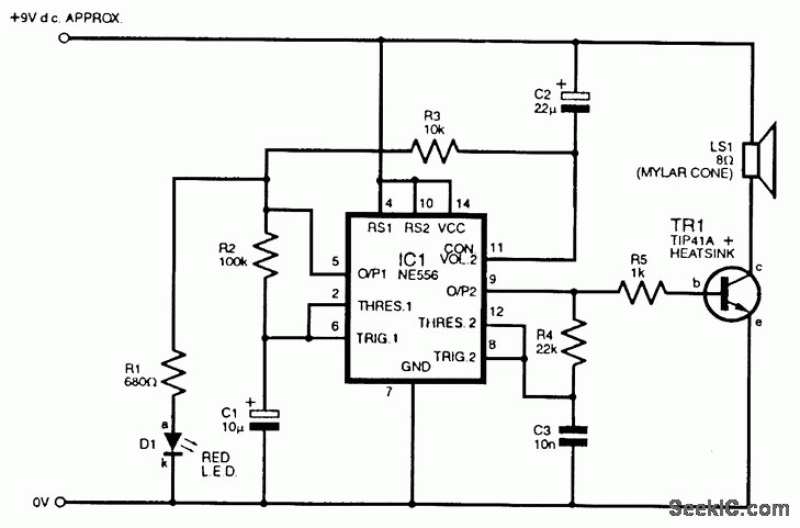
Wailing Alarm Siren

The wailing alarm circuit diagram includes the following component parts: R1 and R5 are 4.7 kΩ resistors, R2 is a 47 kΩ resistor, R3 is a 10 kΩ resistor, R4 is a 100 kΩ resistor, and Rx is specified in the text. The capacitors are C1 and C4 with a value of 100 µF at 25V, electrolytic, and C2 and C3 are 0.01 µF (10 nF) capacitors.
The wailing alarm circuit is designed to produce a loud sound when triggered, typically used in security systems or alert applications. The circuit operates by utilizing a combination of resistors and capacitors to create an oscillating signal that drives a piezoelectric buzzer or speaker.
The resistors R1, R2, R3, and R4 form a voltage divider and help set the operating point for the circuit. Resistor Rx, while not explicitly defined, would typically be used to adjust the sensitivity or frequency of the oscillation depending on the desired characteristics of the alarm. The values of the resistors are chosen to ensure that the circuit operates within a specific frequency range, which is crucial for generating the wailing sound.
Capacitors C1 and C4 are used for power supply filtering and stability, ensuring that the circuit receives a steady voltage. The electrolytic capacitors can handle higher currents and are essential for smoothing out any voltage fluctuations. Capacitors C2 and C3, with their smaller capacitance values, are likely used for timing purposes, helping to set the oscillation frequency of the circuit.
When the circuit is activated, the combination of these components allows for rapid charging and discharging of the capacitors, creating a square wave output that drives the alarm. The output can be connected to a loudspeaker or buzzer, producing the characteristic wailing sound that serves to alert individuals to a potential security breach or emergency situation. Proper layout and connection of these components are critical to ensure reliable operation and optimal performance of the alarm circuit.Here the wailing alarm circuit diagram: Component parts List: R1,R5 4.7KR2 47KR3 10KR4 100KRx *see text C1,C4 100uF/25V, electrolyticC2,C3 0.01uF (10nF),.. 🔗 External reference
The wailing alarm circuit is designed to produce a loud sound when triggered, typically used in security systems or alert applications. The circuit operates by utilizing a combination of resistors and capacitors to create an oscillating signal that drives a piezoelectric buzzer or speaker.
The resistors R1, R2, R3, and R4 form a voltage divider and help set the operating point for the circuit. Resistor Rx, while not explicitly defined, would typically be used to adjust the sensitivity or frequency of the oscillation depending on the desired characteristics of the alarm. The values of the resistors are chosen to ensure that the circuit operates within a specific frequency range, which is crucial for generating the wailing sound.
Capacitors C1 and C4 are used for power supply filtering and stability, ensuring that the circuit receives a steady voltage. The electrolytic capacitors can handle higher currents and are essential for smoothing out any voltage fluctuations. Capacitors C2 and C3, with their smaller capacitance values, are likely used for timing purposes, helping to set the oscillation frequency of the circuit.
When the circuit is activated, the combination of these components allows for rapid charging and discharging of the capacitors, creating a square wave output that drives the alarm. The output can be connected to a loudspeaker or buzzer, producing the characteristic wailing sound that serves to alert individuals to a potential security breach or emergency situation. Proper layout and connection of these components are critical to ensure reliable operation and optimal performance of the alarm circuit.Here the wailing alarm circuit diagram: Component parts List: R1,R5 4.7KR2 47KR3 10KR4 100KRx *see text C1,C4 100uF/25V, electrolyticC2,C3 0.01uF (10nF),.. 🔗 External reference
Warning: include(partials/cookie-banner.php): Failed to open stream: Permission denied in /var/www/html/nextgr/view-circuit.php on line 713
Warning: include(): Failed opening 'partials/cookie-banner.php' for inclusion (include_path='.:/usr/share/php') in /var/www/html/nextgr/view-circuit.php on line 713





